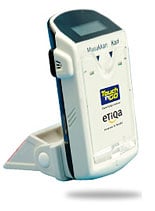 The government’s proposal to implement a MLFF (Multi-Lane Free Flow) electronic toll collection system here in Malaysia will be ready by the end of this year. We first heard of this sometime in mid-2008 where it was announced that a trial of a MLFF system sponsored by Mitsubishi would start at the LDP’s Sungai Penchala Toll plaza from November 2008 onwards.
The government’s proposal to implement a MLFF (Multi-Lane Free Flow) electronic toll collection system here in Malaysia will be ready by the end of this year. We first heard of this sometime in mid-2008 where it was announced that a trial of a MLFF system sponsored by Mitsubishi would start at the LDP’s Sungai Penchala Toll plaza from November 2008 onwards.
Later it seems that this was changed to the Batu 3 toll plaza on the Federal Highway from December 2008 onwards, so it’s been running for about half a year now. I’m sure you’ve noticed one particular lane with eerie purplish lighting – that’s the test lane, which is shared with a SmartTAG lane.
Malaysians currently use the SmartTAG system (photo shown above) which is based on infrared. Of course as you know infrared is essentially light, and might be affected by car tints. The SmartTAG system also needs you to slow your car down significantly before it can pick up your SmartTAG. It is a two-piece system which uses a SmartTAG combined with a Touch n Go card.
The MLFF system currently on trial is a single piece unit (no separate Touch n Go card) that uses microwave transmission technology instead of infrared. There are approximately 1,000 users currently on the trial. It does not carry any value, and if it is stolen all you need to do is report it and the unit will be delinked from your account. There will be no toll lanes or automatic barriers – it will work via a gantry system. This allows you to just drive past the gantry and the appropriate toll collection will happen electronically and automatically.
In case you don’t know, a gantry is essentially a structure that goes overhead above the road. If you’ve been to Singapore you will be able to see various gantries for ERP (Electronic Road Pricing) toll collection around town. The Singaporean ERP system also uses Mitsubishi products.
Of course there will be various issues to settle with an MLFF system, such as cars that drive around without a MLFF tag. Gantries need to have a way to detect cars that do not have an MLFF tag, or have insufficient credits in their account that caused the electronic toll collection to fail. These cars will have to be recognised via some form of automatic number plate recognition to be billed or fined.
Looking to sell your car? Sell it with Carro.











AI-generated Summary ✨
Comments express a generally positive outlook on the upcoming MLFF electronic toll system, noting its potential to reduce traffic congestion and improve convenience, especially for frequent highway users. Many highlight the longstanding presence of existing systems like Touch N’ Go and SmartTag, emphasizing the need for integration and better enforcement, such as receipt issuance for claims. Several comments discuss the technological aspects, including the transition from infrared to microwave-based systems and the importance of standardized number plates for enforcement. There is some skepticism about how quickly the new system will be implemented, with concerns about job losses for toll operators and the political and regulatory hurdles. Overall, the comments suggest high anticipation for the system’s benefits, coupled with a desire for affordability, enforcement, and seamless integration.